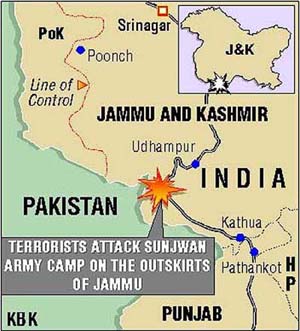Why in news?
The Sunjwan Army camp near Chenni in Jammu was recently attacked suspectedly by Jaish-e-Mohammed (JeM) militants.
What happened?
- At least three terrorists are said to have entered the camp through a nullah (water stream).
- Six persons, including 5 soldiers and a civilian, were killed.
- 3 suspected JeM terrorists were killed in Army's retaliatory action.
- A large quantity of arms and ammunition was seized from them.
- The army continued with the search operation at the camp.

Is this new?
- This is not the first time the Sunjuwan Army camp is targeted.
- In 2003, it was attacked by 2 fidayeen, and 12 soldiers were killed.
- They were said to have cut a wire fence on their way in.
- Other notable attacks in the recent past include the following -
- 2002 - Kaluchak, where terrorists targeted a tourist bus and an Army camp, killing 38
- 2003 - fidayeen entered the Army camp in Tanda, north of Jammu, and killed 8 men
- 2015 - attack on a camp on the Jammu-Pathankot National Highway in Samba district; 2 army personnel were killed
- 2015 - militants stormed a police station in Kathua, killing 7 people
- 2016 - fidayeen targeted an Army camp in Nagrota in Jammu, killing 7 soldiers
What is the perpetual problem?
- Civilian settlements - Jammu city alone has 5 major Army camps under the Western Command.
- These are Chatha, Ratnuchak, Kaluchak, Satwari and Sunjuwan.
- Besides, there are a couple of smaller camps.
- Each of these small and large bases is surrounded by civilian settlements, with hotels, malls and even schools lining up.
- The militants often choose these vulnerable sites with sprawling civilian population with women and children as their targets.
- Efforts at evicting people closer to the camps have seen opposition from property owners and matters still remain in the court.
- These make it difficult to monitor the militants' movements and thwart their plans.
- Security - Army camps in the Jammu region have for long been vulnerable to militant attacks.
- Notably, many of the camps are protected only by barbed wire.
- Fortifying the camps is essential for securing them.
- But converting camps in the middle of thickly populated urban areas into permanent fortresses is hardly possible.
What were the responses?
- After the earlier Sunjwan attack and 2016 Pathankot attack, fortifying the army camps was increasingly pushed for.
- Strengthening the fortifications was also suggested.
- “Smart” access control and fencing with sensors and alarm systems to detect intrusions in real time were suggested.
- However, army camps still employ only limited resources and low cost solutions.
- E.g. using treated Iron sheets to plug gaps in the wall
- Only as the recent attack was underway, the government sanctioned around Rs 1,500 crore.
- This was for perimeter fortification at military installations across India.
What should be done?
- It is important that any plan to address the issue of attacks should be multi-pronged.
- Clearly, camp security is just one aspect.
- Boundary walls, some sort of smart fencing, sensors, a control room to monitor the perimeter are some of the options.
- Security plans for camps must remain “dynamic” to keep pace with changing environments around them due to the civilian push.
- Consolidation i.e. squeezing of smaller pockets of camps into bigger ones is another important aspect.
- This may make it easier for guarding the troops that are spread out.
- The plan must also include bringing down the levels of infiltration from across the border.
- A combination of manpower and smart technology should be employed.
Source: Indian Express
